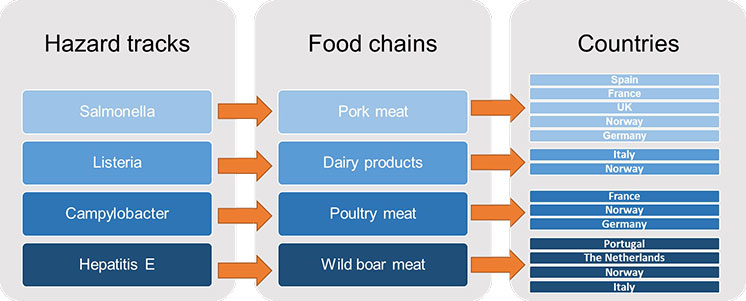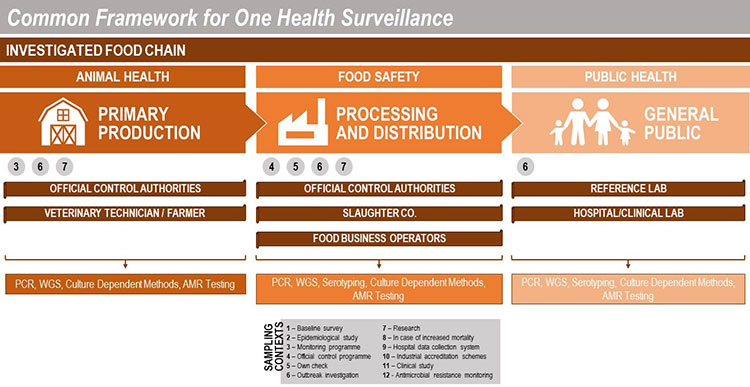MATRIX: integrated and multisectoral surveillance in a One Health perspective
The One Health approach, an integrated concept envisioning a single system that includes people, animals, plants and the environment, is considered a priority in a world where 75% of infectious diseases affecting humans are of animal origin (zoonoses) (Taylor et al.,2001). Besides, imposing a deep cultural and conceptual change in the way of seeing reality and addressing the health challenges of the coming years (Scagliarini et al.,2022), the One Health approach requires a strong collaboration between various disciplines, maybe not always used to such interaction (Ghai et al., 2022).
In this framework, the “MATRIX - Connecting Dimensions in One Health Surveillance” project was designed both to assess the existing situation as well as to propose procedures and guidelines for health surveillance in a One Health perspective (One Health EJP, 2020). The collection of data, their sharing, analysis and interpretation, up to the dissemination of results, are key elements when dealing with an emerging disease or a full-scale health emergency. However, the various sectors involved at national level in dealing with these issues (animal health, food safety and public health) may not have in place efficient and consolidated methods for the exchange of information and collaboration. The connection between sectors represents therefore the main objective of MATRIX, which aims not at the creation of new methods, but at the evaluation, enhancement and integration of resources already available in various countries.
Born as part of the "One Health European Joint Program" (OHEJP), MATRIX started in 2020 with the participation of 19 partners from 12 European countries and will end next December 2022. The Istituto Zooprofilattico Sperimentale (IZSAM) of Teramo, Italy, participates as Project Leader of Work Package 2 "Integrative Strategic Research Agenda", aimed at the examination of existing health surveillance procedures in the various countries and the subsequent creation of guidelines for the advancement of intersectoral collaboration from a One Health perspective.
The first step was the analysis of the situation. Based on two previous OHEJP projects ("NOVA" for the methodology of food chain mapping and "ORION" for the definition of a standard glossary), questionnaires were designed to collect information on surveillance methods. Four pathogens (hazard-tracks) were chosen as references in specific food chains: in addition to the well-known ones (Salmonella in pork; Listeria in dairy products; Campylobacter in chicken meat), Hepatitis E virus (in wild boar meat) was included as an example of emerging disease. Existing surveillance methods in the areas of animal health, food safety and public health were examined for all four hazard-track and food chain combinations (Figure 1) (Cito F. et al., 2022a). After this phase, participants of Work Package 2 examined in detail, during an online workshop held on 7 October 2021, the types of information that are shared in their respective countries, discussing how to improve multisectoriality over the next few years with the aim of implementing a more efficient One Health surveillance.

Figure 1. Hazard track – food chain combinations selected and countries that participated to the survey
Results from these surveys showed that in most cases the surveillance systems are substantially efficient, in each sectors. It was also possible to identify the institutes and laboratories responsible for data management at national level, defining potential "contact points" for cross-sectoral collaborations (Cito F. et al., 2022a). From this point of view, the workshop highlighted how good collaboration and adequate exchange of information between different sectors are implemented in some countries, but mostly only during disease outbreaks. These emergencies can provide valuable lessons in order to define regular and constant procedures, based not on the exchange of raw data, but on the sharing of information already processed by experts in the various sectors, pooled for an overall assessment. The resulting real-time One Health vision will be able to guide the choices and the necessary actions.
Based on the information gathered and the workshop results, Work Package 2 moved to its third objective: the implementation of “best practices” in the form of guidelines, aimed to facilitate strategies for inter and multi-sectoral collaboration. Guidelines and regulations for specific surveillance of the various pathogens are already implemented, both at European level and by international organizations such as WHO, FAO and WOAH. For this reason, the best practices identified by the MATRIX project are proposed as suggestions, in order, for the existing surveillance systems, to be able to interact in a One Health framework at all levels (i.e. data collection, data sharing, analysis, interpretation, dissemination of results). Once facilitators, barriers and perspectives of each level were taken into consideration, it was possible to define specific recommendations for data integration and interoperability in the fields of animal health, food safety and public health (Cito F. et al., 2022b).
Such a coordinated and multisectoral surveillance system could be an essential tool for defining prevention and intervention strategies. For this reason, MATRIX focused its guidelines on three specific goals, where the
One Health vision can make a decisive contribution to operational decisions:
- Measure the impact of the specific disease on human and animal health, monitoring the evolution over time
- Facilitate rapid outbreak detection and response
- Identify risk factors in order to establish effective control measures.

Figure 2. General One Health Surveillance Chain Map
For more information, please visit the following links:
References
- Cito, F., Amato, L., Ågren, E., et al. (2022a). Deliverable D-JIP-MATRIX-WP2.1 mapping of the surveillance chain for all hazard tracks, and cross-sectorial linkages
- Cito, F., Amato, L., Skjerdal, T., et al. (2022b). Deliverable D-JIP-MATRIX-WP2.2 Best practices. Zenodo
- Friesema, I., Eves, C., (2022). Deliverable D-JIP-MATRIX-WP2.3 common framework of ohs surveillance
- Ghai, R.R., Wallace, R.M., Kile, J.C. et al. A generalizable one health framework for the control of zoonotic diseases. Sci Rep 12, 8588 (2022)
- One Health EJP (2020) MATRIX: Connecting dimensions in One-Health surveillance, One Health EJP website
- Scagliarini A, Peltoniemi O, Michel AL. Editorial: Taking a Fresh Look at Old Zoonoses, What Have We Been Missing in One Health Research and Education? Front Public Health. 2022 Apr 25;10:895277. doi: 10.3389/fpubh.2022.895277
- Taylor Louise H., Latham Sophia M. and woolhouse Mark E.J. 2001. Risk factors for human disease emergence. Phil. Trans. R. Soc. Lond. B356983–989. doi: 10.1098/rstb.2001.0888.
Cito F.*, Amato L. , Bonanni A.
Istituto Zooprofilattico Sperimentale dell’Abruzzo e del Molise “G. Caporale”
Centro Operativo Veterinario per l'Epidemiologia, Programmazione, Informazione e Analisi del Rischio
Corresponding author: f.cito@izs.it